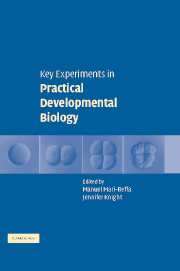Book contents
- Frontmatter
- Contents
- List of contributors
- Preface
- Introduction
- SECTION I GRAFTINGS
- SECTION II SPECIFIC CHEMICAL REAGENTS
- SECTION III BEAD IMPLANTATION
- SECTION IV NUCLEIC ACID INJECTIONS
- SECTION V GENETIC ANALYSIS
- SECTION VI CLONAL ANALYSIS
- SECTION VII IN SITU HYBRIDIZATION
- SECTION VIII TRANSGENIC ORGANISMS
- 19 Bicoid and Dorsal: Two transcriptions factor gradients which specify cell fates in the early Drosophila embryo
- 20 Significance of the temporal modulation of Hox gene expression on segment morphology
- 21 The UAS/GAL4 system for tissue-specific analysis of EGFR gene function in Drosophila melanogaster
- 22 Neurogenesis in Drosophila: A genetic approach
- 23 Role of the achaete-scute complex genes in the development of the adult peripheral nervous system of Drosophila melanogaster
- SECTION IX VERTEBRATE CLONING
- SECTION X CELL CULTURE
- SECTION XI EVO–DEVO STUDIES
- SECTION XII COMPUTATIONAL MODELLING
- Appendix 1 Abbreviations
- Appendix 2 Suppliers
- Index
- Plate Section
- References
21 - The UAS/GAL4 system for tissue-specific analysis of EGFR gene function in Drosophila melanogaster
Published online by Cambridge University Press: 11 August 2009
- Frontmatter
- Contents
- List of contributors
- Preface
- Introduction
- SECTION I GRAFTINGS
- SECTION II SPECIFIC CHEMICAL REAGENTS
- SECTION III BEAD IMPLANTATION
- SECTION IV NUCLEIC ACID INJECTIONS
- SECTION V GENETIC ANALYSIS
- SECTION VI CLONAL ANALYSIS
- SECTION VII IN SITU HYBRIDIZATION
- SECTION VIII TRANSGENIC ORGANISMS
- 19 Bicoid and Dorsal: Two transcriptions factor gradients which specify cell fates in the early Drosophila embryo
- 20 Significance of the temporal modulation of Hox gene expression on segment morphology
- 21 The UAS/GAL4 system for tissue-specific analysis of EGFR gene function in Drosophila melanogaster
- 22 Neurogenesis in Drosophila: A genetic approach
- 23 Role of the achaete-scute complex genes in the development of the adult peripheral nervous system of Drosophila melanogaster
- SECTION IX VERTEBRATE CLONING
- SECTION X CELL CULTURE
- SECTION XI EVO–DEVO STUDIES
- SECTION XII COMPUTATIONAL MODELLING
- Appendix 1 Abbreviations
- Appendix 2 Suppliers
- Index
- Plate Section
- References
Summary
OBJECTIVE OF THE EXPERIMENT Genetic methodologies have historically provided an important means for unraveling the mysteries of development. The GAL4/UAS system in Drosophila melanogaster provides one such example. This bipartite genetic system, based on the yeast transcriptional activator GAL4, was constructed in 1993 as a means to direct gene expression in vivo (Brand and Perrimon, 1993). The system is based on the ability of GAL4 to bind to an Upstream Activating Sequence (UAS) element and stimulate transcription of the associated gene (responder). By placing GAL4 under the control of tissue-specific regulatory elements, transcription of the responder can be directed in a similar pattern. Because expression of the responder is dependent on the presence of GAL4, the absence of GAL4 renders the responder gene transcriptionally silent. With a simple mating scheme, GAL4 and the responder can be combined, resulting in expression of the responder (Figure 21.1). In this chapter we describe experiments that explore the utility of the GAL4/UAS technique in the study of post-embryonic development in the fly.
As our knowledge of development has increased, we have come to realize that many genes are often required at multiple stages throughout the life cycle. While providing an example of developmental efficiency, it simultaneously presents an experimental hurdle that must be overcome in order to assess the role of such genes in any one spatial or temporal context. This is evident in the case of developmental processes involving cellular communication, which rely heavily upon conserved signal transduction modules.
- Type
- Chapter
- Information
- Key Experiments in Practical Developmental Biology , pp. 269 - 281Publisher: Cambridge University PressPrint publication year: 2005



